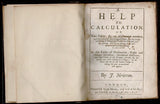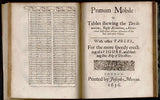A help to calculation. Or two tables: the one of decimal numbers, and the other of their logarithms, for the ready converting of sexagenary tables into decimal, and the contrary.
Author: Newton, John (1622-1678)
Year: 1657
Publisher: Printed by Joseph Moxon
Place: London
Description:
100+[4] pages with tables and title within ruled boarder. Small quarto (7 1/2" x 5 3/4") bound in 20th century half green morocco with gilt lettering to spine over marbled boards. (Thomash & Williams N33; Wing N1060) First edition.
John Newton remained loyal to the king during the protectorate, and supported himself by his eminent skill in mathematics and astronomy. At the Restoration he obtained the degree of D.D., and was in 1661 made king's chaplain and rector of Ross in Herefordshire, where he died on 25 Dec. 1678. He was appointed canon of Hereford in 1673, and held the rectory of Upminster in Essex from 1662. He was the author of several works on arithmetic and astronomy, designed to facilitate the use of decimal notation and logarithmic methods. He was also an advocate of educational reform in grammar schools; he protested against the narrowness of the system which taught Latin and nothing else to boys ignorant of their mother tongue; and complained that hardly any grammar-school masters were competent to teach arithmetic, geometry, and astronomy. With the object of supplying the means of teaching a wider and more practical curriculum, he wrote school-books on these subjects, and also on logic and rhetoric. The following is a list of his works in chronological order; they are all in English: 1. 'Institutio Mathematica.' Decimal tables of natural sines, tangents, and secants, and of logarithms; solution of plane and spherical triangles; with applications to astronomy, dialling, and navigation, 1654. 2. 'Astronomia Britannica,' so called because decimals are used and the calculations are made for the meridian of London. In two books, dedicated to the Earl of Warwick, who was an admiral of the fleet, 1657. This and the foregoing work were printed by William Leybourn [q. v.] 3. 'Help to Calculation,' 1657. 4. 'Sixteenpence in the Pound,' an interest table, 1657. 5. 'Trigonometria Britannica,' in two books, one of them from the Latin of Henry Gellibrand, 1658. 6. 'Chiliades centum Logarithmorum,' 1659. 7. 'Geometrical Trigonometry,' 1659. 8. 'Mathematical Elements,' three parts, 1660. 9. 'A Perpetual Diary or Almanac,' 1662. 10. 'Description of Use of Carpenter's Rule,' 1667. 11. 'Ephemerides of Interest and Rate of Money at 6 per cent.' 1667. 12. 'Chiliades centum Logarithmorum et Tabula partium Proportionalium,' 1667. 13. 'The Scale of Interest: or the Use of Decimal Fractions and Table of Logarithms,' composed and published for the use of an English mathematical and grammar school to be set up at Ross in Herefordshire, 1668. This book contains two dedications, one to the Archbishop of Canterbury and the Bishops of London and Hereford, the other to Lord Scudamore and other property owners about Ross. His views on grammar-school education are expounded in a preface of thirty-six pages. 14. 'School Pastime for Young Children,' dedicated to Thomas Foley, 1669, contains a preface of eighteen pages on the education of infants. 15. 'Art of Practical Gauging,' 1669. 16. 'Introduction to the Art of Logic,' 1671, dedicated to Henry Milberne. 17. 'Introduction to the Art of Rhetoric,' 1671. 18. 'The Art of Natural Arithmetic,' 1671. 19. 'The English Academy, or a brief Introduction to the Seven Liberal Arts,' 1677. 20. 'Introduction to Geography,' 1678. 21. 'Cosmography,' 1679. 22. 'Introduction to Astronomy.' The present work, published by Joseph Moxon for sale in his instrument shop, is designed to aid in the conversion from sexagesimal to decimal numbers so that problems in astronomy, navigation, etc. can more easily be solved using the standard logarithmic tables. After a short introduction, the majority of the volume is taken up by the tables.
Condition:
Points and spine ends rubbed, ink stamp to title verso else very good.








